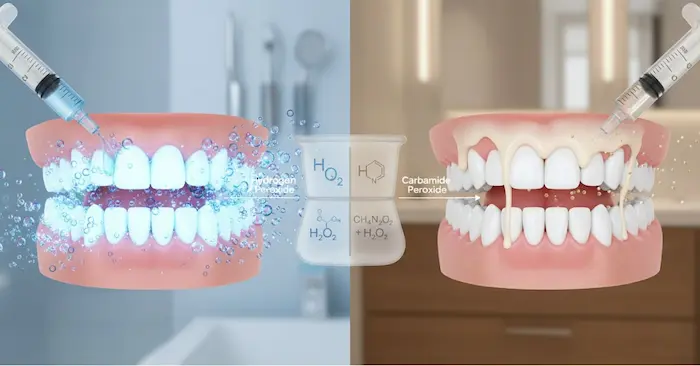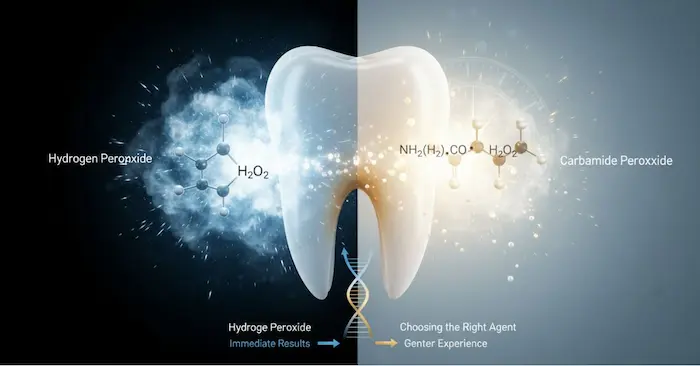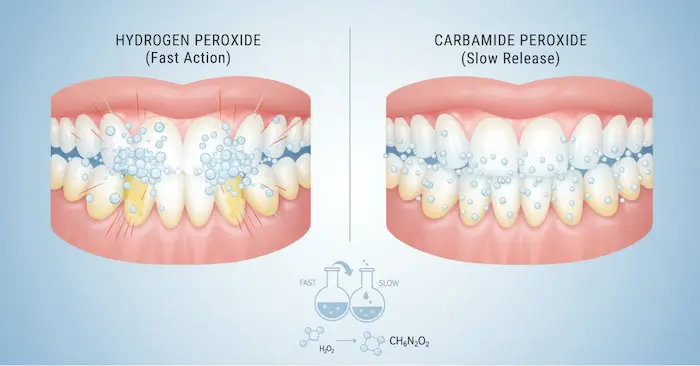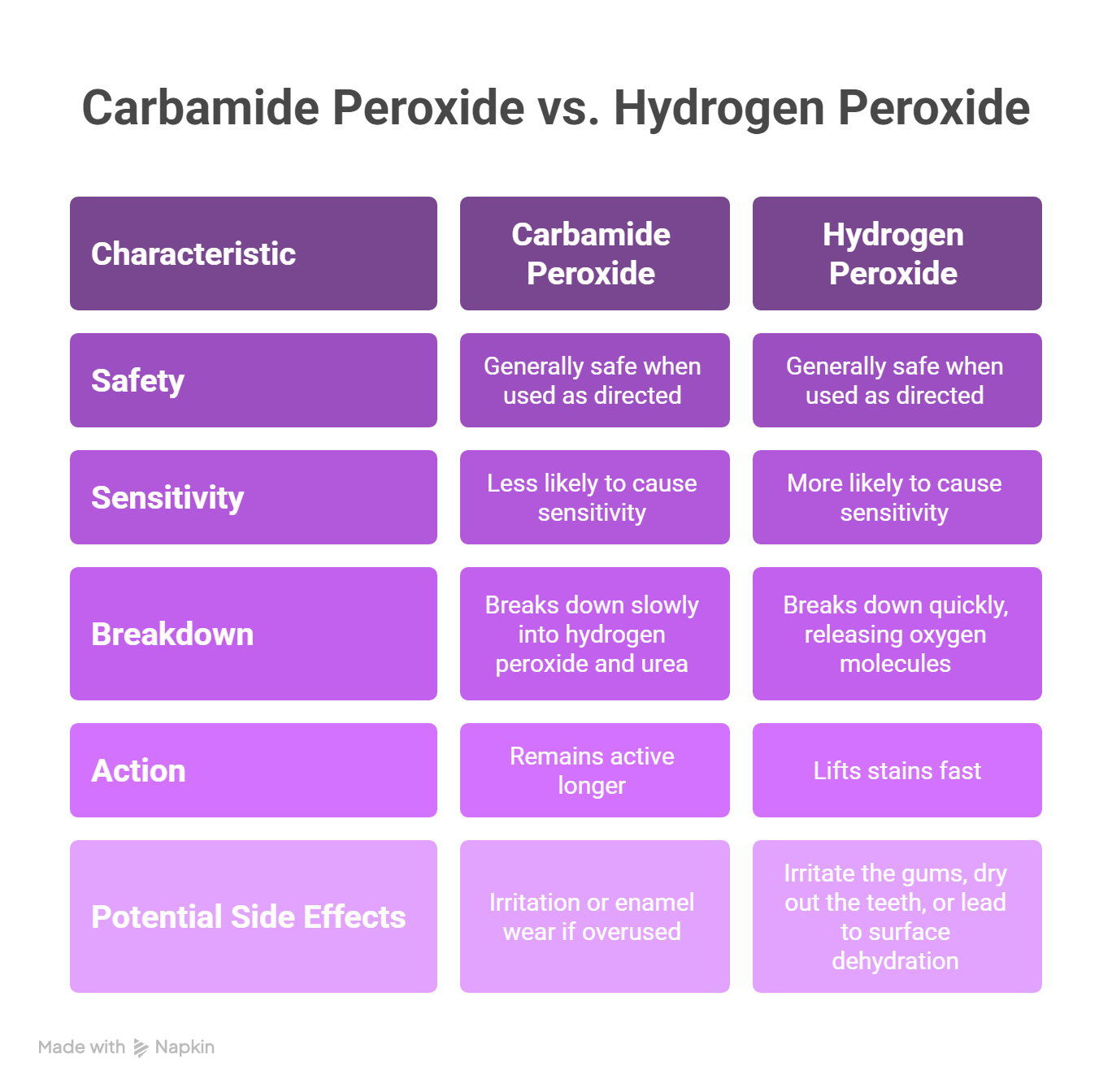Struggling to choose between carbamide peroxide vs hydrogen peroxide for your teeth whitening routine? Each ingredient works differently, especially if you have sensitive teeth or are aiming for long-lasting results.
This article explains the key differences, including how they work, which is gentler, and what delivers faster results. Whether you're looking for immediate brightness or gradual whitening with less sensitivity, this guide will help you decide the best option for your smile.
Key Takeaways
-
Carbamide peroxide offers greater stability and sustained whitening effects through gradual decomposition into hydrogen peroxide, making it suitable for long-term treatments.
-
Hydrogen peroxide provides faster whitening results due to its immediate action but may lead to higher tooth sensitivity compared to carbamide peroxide.
-
Regulatory guidelines vary by region, ensuring safe usage of teeth whitening products, with professional supervision recommended for higher concentrations.
What’s the Difference Between Carbamide Peroxide and Hydrogen Peroxide?
When it comes to

teeth whitening, two ingredients dominate most product labels: carbamide peroxide and hydrogen peroxide. While both are effective bleaching agents, they differ in how they work, how quickly they act, and how suitable they are for different users.
Understanding these differences helps you choose the right option for your whitening routine especially if you have sensitive teeth, time constraints, or are looking for long-term results.
What is Hydrogen Peroxide?
Hydrogen peroxide is a fast-acting whitening agent often found in professional teeth whitening treatments. It works by releasing oxygen molecules that penetrate the enamel and break apart stains and discoloration. Because it acts quickly, it’s commonly used in in-office treatments or whitening strips designed for immediate results.
-
Concentration: In professional settings, hydrogen peroxide can be used in strengths up to 35%, though lower concentrations (3% to 10%) are common in over-the-counter products.
-
Shelf Life: Hydrogen peroxide is less stable and can degrade faster if not stored properly, especially when exposed to heat or light.
What is Carbamide Peroxide?
Carbamide peroxide is a compound made of hydrogen peroxide and urea. When it contacts moisture, it breaks down slowly, releasing hydrogen peroxide over time. This slower decomposition process makes it gentler on tooth enamel and gums, which is ideal for people with tooth sensitivity.
-
Concentration: Ranges from 10% to 44%, typically translating to about one-third the hydrogen peroxide strength. For example, 30% carbamide peroxide equals roughly 10% hydrogen peroxide.
-
Shelf Life: Carbamide peroxide is more stable than hydrogen peroxide, making it a better option for products that are stored over time, like whitening trays for at-home use.
Chemical Differences Between Carbamide Peroxide and Hydrogen Peroxide

To choose the right whitening agents, it’s helpful to understand how carbamide peroxide and hydrogen peroxide differ in their chemical makeup. These two ingredients are common in whitening gels, strips, and professional systems, but they behave differently once applied.
Hydrogen peroxide is a fast-acting compound that begins working immediately upon contact. It releases free radicals that break down stains on the tooth surface. This process is why hydrogen peroxide breaks down stains quickly, making it a go-to for fast results.
Carbamide peroxide, on the other hand, is a more stable compound. It combines hydrogen peroxide and carbamide (urea). When applied, carbamide peroxide releases hydrogen peroxide slowly, creating a longer-lasting whitening effect with less irritation for people with sensitive teeth. This gradual breakdown makes it ideal for overnight whitening gels or custom trays provided by your local dentist.
Compared to hydrogen peroxide, carbamide peroxide is less prone to degrade from light or temperature changes. That means carbamide peroxide and hydrogen peroxide products can offer different shelf lives and whitening consistency.
-
Hydrogen peroxide tends to act fast but loses potency more quickly
-
Carbamide peroxide maintains effectiveness over time, supporting whitening teeth over longer sessions
Because of this stability, carbamide peroxide and hydrogen peroxide are often used in different scenarios. Carbamide is preferred for longer wear, while hydrogen is ideal for short, high-impact treatments.
For people prone to irritation, carbamide peroxide’s slower breakdown means fewer sharp reactions during or after whitening. Many clinical evaluation studies suggest this ingredient may reduce sensitive teeth issues while still delivering whitening benefits. While hydrogen peroxide works faster, it is more likely to irritate the gums or enamel if used too frequently or in high concentrations.
Both carbamide peroxide and hydrogen peroxide are effective whitening ingredients. The key is choosing the one that fits your needs, whether you want immediate results or a gentler, more controlled experience. While they may not produce exactly the same results in the same timeframe, both can help you safely brighten your smile when used as recommended.
How Carbamide Peroxide and Hydrogen Peroxide Whiten Your Teeth

If you're wondering how these ingredients actually work, the answer comes down to chemistry. Both carbamide peroxide and hydrogen peroxide are powerful whitening agents, but they work at different speeds, and that can affect your comfort and results.
Hydrogen peroxide starts working almost immediately. Once applied, it breaks down and releases oxygen that targets stains on and beneath the enamel. This fast action is what makes it popular in whitening gels used at the dentist’s office or in short treatments at home. However, because hydrogen peroxide breaks down so quickly, it may also increase the chances of sensitive teeth, especially if you’re using a high concentration.
Carbamide peroxide, on the other hand, takes a slower, more gradual approach. It breaks down into hydrogen peroxide and urea over time, which allows the whitening process to last longer and feel gentler. This makes it a great choice for overnight trays or anyone looking for steady, consistent results. Carbamide peroxide releases the whitening ingredients more slowly, which helps reduce irritation.
Studies back this up. One lab test found that 16% carbamide peroxide worked just as well as 6% hydrogen peroxide when used over 14 days but with less enamel stress. Another review confirmed that a 10% carbamide peroxide formula can deliver exactly the same results as stronger hydrogen peroxide, with fewer side effects.
Of course, both ingredients come with some risks. A recent study (Khalij-Libya Journal, 2024) found that both peroxides can slightly weaken enamel by reducing minerals like phosphate. That’s why it's important to use them properly and avoid overuse.
If you’ve got sensitive teeth, carbamide peroxide might be the better choice. It gives your smile time to brighten without overwhelming your enamel. And according to the American Dental Association, it’s a safe and proven option for many whitening routines.
Not sure which is right for you? A quick clinical evaluation with your local dentist can help you choose the safest and most effective option based on your goals.
Which Teeth Whitening Agent Works Better: Carbamide or Hydrogen Peroxide?
When it comes to results, both carbamide peroxide and hydrogen peroxide are proven whitening agents. The real difference comes down to how fast they work and how your teeth respond.
Hydrogen peroxide acts quickly and may give you slightly more dramatic results in less time. It's often used in-office or for quick whitening before events. But this speed can increase tooth sensitivity, especially at higher peroxide levels.
Carbamide peroxide takes longer to whiten, but it is much gentler — making it a great fit for sensitive teeth. It’s also more stable and has a slightly longer shelf life, which is helpful for products like at-home whitening trays.
Despite the difference in speed, multiple studies show that carbamide peroxide can deliver exactly the same results as hydrogen peroxide when used consistently over time.
If you’re unsure which is right for your goals, a quick clinical evaluation with your local dentist can help. They’ll assess your enamel, sensitivity level, and lifestyle to recommend the safest and most effective whitening options.
The American Dental Association also recommends looking for approved products with clinically tested peroxide levels to ensure safe and effective results. While oxygen molecules penetrate enamel in both methods, how you use them, and how often, matters just as much as the ingredient itself.
Safety Profile and Side Effects of Carbamide and Hydrogen Peroxide

Both carbamide peroxide and hydrogen peroxide are generally safe whitening ingredients when used as directed. But like all whitening products, they carry potential side effects, especially if you're using higher concentrations or applying them for longer periods.
Hydrogen peroxide tends to cause sensitivity more often, especially at stronger peroxide levels. It breaks down quickly and gets deep into the enamel, releasing oxygen molecules that lift stains fast. That fast action can sometimes irritate the gums, dry out the teeth, or lead to surface dehydration.
In contrast, carbamide peroxide breaks down slowly into hydrogen peroxide and urea, which is why it's often preferred by patients with sensitive teeth. It remains active longer, giving you the same whitening results with less discomfort. But even this gentler formula can cause irritation or enamel wear if overused.
To avoid risk:
-
Use products with lower concentrations for at-home treatments.
-
Avoid using whitening gels with harsh active ingredients too frequently.
-
Stick to application times suggested by your dentist or manufacturer.
According to the American Dental Association, peroxide-based whitening gels are safe when applied correctly. They also recommend avoiding over-the-counter products with unregulated peroxide levels, as misuse can lead to enamel erosion or lasting sensitivity.
Whether you’re using hydrogen peroxide or carbamide peroxide, always follow usage guidelines, avoid excessive applications, and consult with your dentist if you notice discomfort.
Regulatory Guidelines on Whitening Peroxides
Safety rules around teeth whitening products vary by country, but the goal is the same: reduce the risk of irritation, enamel damage, and misuse.
In Australia, only licensed dentists can use higher concentrations (above 6% hydrogen peroxide or 18% carbamide peroxide). This ensures professional oversight for stronger treatments.
In the European Union, the maximum allowed peroxide levels for professional whitening is 6% hydrogen peroxide or equivalent carbamide peroxide (around 17%).
In the US, the American Dental Association has given its Seal of Acceptance to certain whitening options, such as a 10±1% carbamide peroxide formula. That seal means the product has passed rigorous safety and effectiveness checks.
Although professional treatments can give dramatic results in a short time, safer at-home gels with lower concentrations are ideal for everyday use. Their slightly longer shelf life also makes them more practical for extended whitening plans.
For best results, choose whitening products that are ADA-approved, follow application instructions closely, and never exceed the recommended duration or strength without guidance.
Clinical Recommendations for Choosing the Right Whitening Treatment
Not sure whether to go with carbamide peroxide or hydrogen peroxide? That depends on your smile goals, your lifestyle, and your current oral health.
If you want faster results and don’t experience much sensitivity, a stronger hydrogen peroxide treatment under a dentist’s care might be ideal.
If you have sensitive teeth, prefer shorter wear times, or want a gentler approach, carbamide peroxide may be the better fit. Its slower breakdown makes it effective without the intensity.
The main difference comes down to comfort versus speed. While both can lift stains and give you a confident smile, carbamide peroxide is less likely to cause irritation, especially with long-term use.
To make an informed choice:
-
Schedule a clinical evaluation with your local dentist
-
Discuss the whitening options that align with your enamel health, past dental work, and expectations
-
Ask about at-home vs. in-office gels, expected sensitivity, and how long results might last
Your dentist can also help you pair treatments with proper maintenance like brushing, flossing, and hydration to extend results.
The American Dental Association showed that following best practices in peroxide use significantly lowers risk and improves whitening outcomes. That means safer treatments, better experiences, and results that last.
Final Thoughts
Both carbamide peroxide and hydrogen peroxide can help you achieve a whiter smile. The right choice depends on what matters most to you: faster results or a gentler experience.
Understanding these differences, and how they affect your enamel, comfort, and whitening timeline, makes it easier to choose a product that fits your lifestyle.
At SNOW, our whitening solutions are formulated to balance effectiveness and sensitivity, using dentist-recommended levels of peroxide in safe, enamel-friendly formulas. Whether you’re whitening for the first time or looking to maintain a bright smile, we’re here to help you do it safely and confidently.
Explore SNOW’s peroxide-powered, sensitivity-safe options today.
Frequently Asked Questions
Your top whitening questions answered:
What is the main difference between carbamide peroxide and hydrogen peroxide for teeth whitening?
The main difference is that hydrogen peroxide acts quickly for immediate whitening results, while carbamide peroxide provides a slower, more gradual whitening effect. Choosing between them depends on your preference for speed versus a more extended process.
Are there any safety concerns with using carbamide peroxide?
Yes, carbamide peroxide can lead to gum irritation and enamel wear if used in high concentrations or too frequently. It's important to follow usage guidelines to minimize these risks.
How long do the results of teeth whitening treatments last?
Teeth whitening results typically last between 6 to 12 months, influenced by the type of treatment and your maintenance habits. Regular care can help prolong the brightness of your smile.
Can I use teeth whitening products with high peroxide levels at home?
Using teeth whitening products with high peroxide levels at home is not advisable; they should only be used under professional supervision to avoid potential risks and side effects.
What should I do if I experience sensitivity during teeth whitening?
If you experience sensitivity during teeth whitening, consult your dentist to adjust your treatment plan for a safer and more comfortable experience.




































































